Table 1.
Degree of Quorum Sensing Inhibition (QSI) coumaperine derivatives *.
| Entry | Monoconjugated-CP | Degree of QSI of CV026 | Degree of QSI of KYC55 |
| 1. |
 CP-215 |
+++ | +++ |
| 2. |
 CP-270 |
+++ | +++ |
| 3. |
 CP-296 |
+++ | +++ |
| 4. |
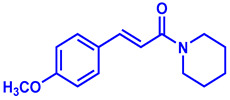 CP-282 |
+++ | ++ |
| 5. |
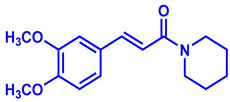 CP-289 |
+ | +++ |
| 6. |
 CP-237 |
++ | ++ |
| 7. |
 CP-295 |
++ | ++ |
| 8. |
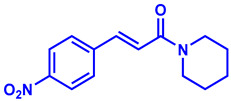 CP-286 |
+ | ++ |
| Entry | Diconjugated-CP | Degree of QSI of CV026 | Degree of QSI of KYC55 |
| 9. |
 CP-154 |
+++ | +++ |
| 10. |
 CP-158 |
+++ | ++ |
| 11. |
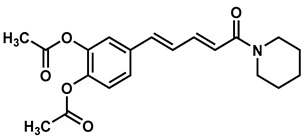 CP-281 F1 |
++ | + |
| 12. |
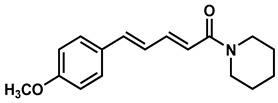 CP-38 |
++ | + |
| 13. |
 CP-9 |
++ | + |
| Entry | Triconjugated-CP | Degree of QSI of CV026 | Degree of QSI of KYC55 |
| 14. |
 CP-102 |
++ | + |
* Two tests were carried out using the reporter bacteria: Agrobacterium tumefaciens (KYC55) and Chromobacterium violaceum (CV026). Bacteria were grown overnight in soft agar with the appropriate autoinducer on a Thin Layer chromatography (TLC) plate where the different compounds were dried on 40 mM in ~20-µL acetonitrile, and their degree of QSI was measured semi-quantitatively by color intensity (+ low inhibition, ++ medium inhibition and +++ strong inhibition). Experiments were repeated three times, and the results were determined by considering at least 2 out of 3 experiments with the same results.
